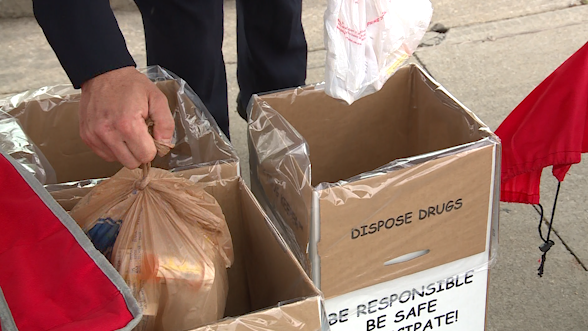

Cynthia Henderson drove up to the Kroger in Spring Grove Village, unloading 2 bags of old prescription drugs.“Putting them in the garbage and landfill is bad for the environment, so that’s important for me," Henderson said. "Also, after having some surgeries, I may have some drugs that could be attractive to some people, and I want them out of my house.”Those two reasons, protecting the environment and deterring crime and abuse, Cincinnati Police Officer Timothy Bley says makes this program so successful.“It gives everybody a safe, responsible and convenient way of disposing of things whether they are narcotics are not," Bley said. "They’re not going to end up in the community, being illegally dealt or abused.”Cincinnati police has partnered with the Drug Enforcement Administration for over 10 years as part of the 20th Semi-annual collection.Elizabeth Hodge, of Clifton, says the April and October collections give her peace of mind. “I like the idea that it is twice per year, because everybody has something they can get rid of out of the medicine cabinet,” Hodge said. Statistics from the DEA illustrate how impactful the program has been. Despite COVID-19, 400 tons of prescription drugs and 6,000 pounds of pills were collected in October. Last fall, Americans turned in nearly 492 tons of prescription drugs at nearly 4,153 sites operated by the DEA and almost 5,000 of its state and local law enforcement partners. Overall, in its 19 previous Take Back events, DEA and its partners have taken in more than 13.6 million pounds of pills.
Cynthia Henderson drove up to the Kroger in Spring Grove Village, unloading 2 bags of old prescription drugs.
“Putting them in the garbage and landfill is bad for the environment, so that’s important for me," Henderson said. "Also, after having some surgeries, I may have some drugs that could be attractive to some people, and I want them out of my house.”
Those two reasons, protecting the environment and deterring crime and abuse, Cincinnati Police Officer Timothy Bley says makes this program so successful.
“It gives everybody a safe, responsible and convenient way of disposing of things whether they are narcotics are not," Bley said. "They’re not going to end up in the community, being illegally dealt or abused.”
Cincinnati police has partnered with the Drug Enforcement Administration for over 10 years as part of the 20th Semi-annual collection.
Elizabeth Hodge, of Clifton, says the April and October collections give her peace of mind.
“I like the idea that it is twice per year, because everybody has something they can get rid of out of the medicine cabinet,” Hodge said.
Statistics from the DEA illustrate how impactful the program has been. Despite COVID-19, 400 tons of prescription drugs and 6,000 pounds of pills were collected in October.
Last fall, Americans turned in nearly 492 tons of prescription drugs at nearly 4,153 sites operated by the DEA and almost 5,000 of its state and local law enforcement partners.
Overall, in its 19 previous Take Back events, DEA and its partners have taken in more than 13.6 million pounds of pills.
Source link






